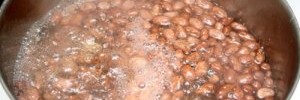Preparing Legumes
Legumes are best prepared by simmering rather than boiling. One cup (1/2 pound) of dried beans usually yields 2 to 2 1/2 cups of cooked beans; 1/2 cup of cooked dried beans or peas may be counted as a 1-ounce serving of meat or as one vegetable serving. Cooked legumes can be eaten plain or mixed and matched with other foods, as in red beans and rice, bean burritos, and tostadas.
There are three methods for preparing dried beans: overnight soak, short soak, and no soak. In the overnight soak method, beans are sorted and thoroughly rinsed and then immersed in water; those that rise to the top or are shriveled are discarded. The remaining beans are soaked in water amounting to three or four times their quantity; i.e., 2 cups of dried beans require 6 to 8 cups of cold water. After soaking for approximately 10 hours, they are either drained and fresh water is added, or they are immediately simmered directly in their soaking liquid until tender. A lid is used but should be shifted slightly to the side to avoid a boil over. During simmering, water is added as needed to compensate for evaporation loss. Soaked beans require a long, slow cooking time to break down their hard-to-digest starches.
In the short soak method, sorted and rinsed beans are brought to a full boil for 2 minutes, removed from the heat, and allowed to soak in the same hot water for one hour. They are then simmered as above in their soaking liquid.
Finally, beans can be prepared without soaking, but they take twice the amount of water and double the heating time; they also lose their skins more easily. The no soak method is used for lentils and split peas because their smaller size results in shorter cooking times.
When cooking legumes, it is important not to use hard water or add salt or acid in the form of tomato products or lemon juice until the beans are well cooked, because these substances inhibit the softening of pectic compounds. Another pitfall that may be encountered with legumes is that flatulence often occurs. Gases (hydrogen, methane, and carbon dioxide) are produced by intestinal bacteria when they ferment the bean’s indigestible carbohydrates, such as raffinose and stachyose. The problem can be minimized by soaking the beans, draining their water, rinsing them well before cooking, and then cooking them properly in fresh water, although this may result in a decrease in nutrients. Enzyme-containing products such as Beano are now available on the market and may also be added to the food before consumption to assist in digestion.
